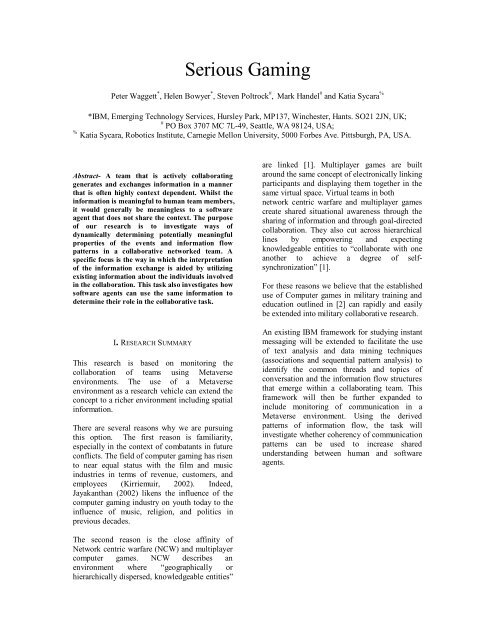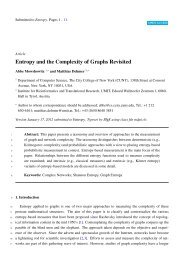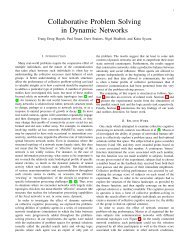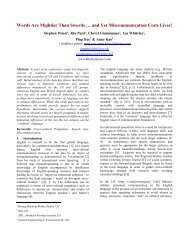Formal properties of distributed database sensor networks
Formal properties of distributed database sensor networks
Formal properties of distributed database sensor networks
You also want an ePaper? Increase the reach of your titles
YUMPU automatically turns print PDFs into web optimized ePapers that Google loves.
Serious Gaming<br />
Peter Waggett * , Helen Bowyer * , Steven Poltrock # , Mark Handel # and Katia Sycara %<br />
*IBM, Emerging Technology Services, Hursley Park, MP137, Winchester, Hants. SO21 2JN, UK;<br />
# PO Box 3707 MC 7L-49, Seattle, WA 98124, USA;<br />
%<br />
Katia Sycara, Robotics Institute, Carnegie Mellon University, 5000 Forbes Ave. Pittsburgh, PA, USA.<br />
Abstract- A team that is actively collaborating<br />
generates and exchanges information in a manner<br />
that is <strong>of</strong>ten highly context dependent. Whilst the<br />
information is meaningful to human team members,<br />
it would generally be meaningless to a s<strong>of</strong>tware<br />
agent that does not share the context. The purpose<br />
<strong>of</strong> our research is to investigate ways <strong>of</strong><br />
dynamically determining potentially meaningful<br />
<strong>properties</strong> <strong>of</strong> the events and information flow<br />
patterns in a collaborative networked team. A<br />
specific focus is the way in which the interpretation<br />
<strong>of</strong> the information exchange is aided by utilizing<br />
existing information about the individuals involved<br />
in the collaboration. This task also investigates how<br />
s<strong>of</strong>tware agents can use the same information to<br />
determine their role in the collaborative task.<br />
I. RESEARCH SUMMARY<br />
This research is based on monitoring the<br />
collaboration <strong>of</strong> teams using Metaverse<br />
environments. The use <strong>of</strong> a Metaverse<br />
environment as a research vehicle can extend the<br />
concept to a richer environment including spatial<br />
information.<br />
There are several reasons why we are pursuing<br />
this option. The first reason is familiarity,<br />
especially in the context <strong>of</strong> combatants in future<br />
conflicts. The field <strong>of</strong> computer gaming has risen<br />
to near equal status with the film and music<br />
industries in terms <strong>of</strong> revenue, customers, and<br />
employees (Kirriemuir, 2002). Indeed,<br />
Jayakanthan (2002) likens the influence <strong>of</strong> the<br />
computer gaming industry on youth today to the<br />
influence <strong>of</strong> music, religion, and politics in<br />
previous decades.<br />
are linked [1]. Multiplayer games are built<br />
around the same concept <strong>of</strong> electronically linking<br />
participants and displaying them together in the<br />
same virtual space. Virtual teams in both<br />
network centric warfare and multiplayer games<br />
create shared situational awareness through the<br />
sharing <strong>of</strong> information and through goal-directed<br />
collaboration. They also cut across hierarchical<br />
lines by empowering and expecting<br />
knowledgeable entities to “collaborate with one<br />
another to achieve a degree <strong>of</strong> selfsynchronization”<br />
[1].<br />
For these reasons we believe that the established<br />
use <strong>of</strong> Computer games in military training and<br />
education outlined in [2] can rapidly and easily<br />
be extended into military collaborative research.<br />
An existing IBM framework for studying instant<br />
messaging will be extended to facilitate the use<br />
<strong>of</strong> text analysis and data mining techniques<br />
(associations and sequential pattern analysis) to<br />
identify the common threads and topics <strong>of</strong><br />
conversation and the information flow structures<br />
that emerge within a collaborating team. This<br />
framework will then be further expanded to<br />
include monitoring <strong>of</strong> communication in a<br />
Metaverse environment. Using the derived<br />
patterns <strong>of</strong> information flow, the task will<br />
investigate whether coherency <strong>of</strong> communication<br />
patterns can be used to increase shared<br />
understanding between human and s<strong>of</strong>tware<br />
agents.<br />
The second reason is the close affinity <strong>of</strong><br />
Network centric warfare (NCW) and multiplayer<br />
computer games. NCW describes an<br />
environment where “geographically or<br />
hierarchically dispersed, knowledgeable entities”
II. METAVERSE LANDSCAPE<br />
The Metaverse concept emerged in the early<br />
1990’s (e.g. Stephenson, 1992). The idea that<br />
simulated environments become completely<br />
immersive and compelling (and therefore a good<br />
simulation <strong>of</strong> real life) has become more<br />
practical as graphical fidelity and modeling tools<br />
have delivered more faithful renditions. However,<br />
each metaverse system is a compromise between<br />
three distinct and conflicting dimensions detailed<br />
in Figure 1.<br />
the perspective <strong>of</strong> their use in our planned<br />
research and may not be appropriate evaluations<br />
for other uses. For example, a major issue with<br />
America’s Army is associated with the licensing<br />
conditions that may be less onerous for some<br />
other applications.<br />
Collaborative<br />
Capabilities<br />
Command<br />
and<br />
Conquer<br />
Second<br />
Life<br />
Battlefield America’s<br />
2 Army<br />
M H H H<br />
Collaboration<br />
Fidelity <strong>of</strong><br />
Simulation<br />
M L H H<br />
Visual<br />
Appeal<br />
Model<br />
Accuracy<br />
Ease <strong>of</strong><br />
Instrumentation<br />
M H H L<br />
Figure 1 Metaverse constructs<br />
The highest degree <strong>of</strong> object fidelity is achieved<br />
by CAD/CAM modelling tools, but these are<br />
difficult s<strong>of</strong>tware packages to learn and use.<br />
Commercial games provide high levels <strong>of</strong> visual<br />
appeal, usability and playability. Collaborative,<br />
social network packages (e.g. Second Life)<br />
provide a high degree <strong>of</strong> collaboration but have<br />
limited capabilities to model objects and poor<br />
visual appeal.<br />
To provide a simulation environment that will<br />
help us answer our research questions we have<br />
been looking for a game environment that<br />
combines acceptable visual appeal with a good<br />
collaboration framework. Model accuracy must<br />
be good but may not need to be spectacular.<br />
Tactical<br />
Simulations<br />
Strategic<br />
Simulation<br />
Table 1 Relative game ratings<br />
M M H H<br />
H L M M<br />
Figure 2 provides representative screen shots for<br />
the games.<br />
Command and Conquer<br />
America’s Army<br />
We conducted a short-listing process across all<br />
the candidate systems identified to reduce the<br />
total down to a final group <strong>of</strong> the four best<br />
matched games for the detailed evaluation.<br />
The final four games were:<br />
Battlefield 2<br />
Second Life<br />
Command and Conquer: Generals<br />
America’s Army<br />
Battlefield 2<br />
Second Life<br />
Our evaluations <strong>of</strong> each game on five criteria are<br />
listed in Table 1. The games were evaluated from<br />
Figure 2. Screen shots <strong>of</strong> the games<br />
On the basis <strong>of</strong> the evaluation we decided to<br />
pursue the Battlefield 2 game as our highest<br />
priority. The following modifications have been<br />
implemented.
III. PLANNING PROGRAM<br />
A significant element <strong>of</strong> the proposed research<br />
questions will be associated with how well (or<br />
otherwise) teams are able to plan and re-plan<br />
during an exercise and how well they can follow<br />
the plans. We require a planning program for<br />
Battlefield 2 with specific requirements. The<br />
basis <strong>of</strong> this program is the planning program<br />
produced by Foolish Entertainment. This<br />
program can be used by the teams before and<br />
during the exercise to produce an action plan.<br />
This outputs an image at the end <strong>of</strong> the session as<br />
well as having assigned job roles to the squad<br />
members. We can capture these images for later<br />
comparison with actual actions and routes.<br />
FEATURES OF THE PLANNING PROGRAM INCLUDE:<br />
• Extremely easy too use. It is possible to create<br />
detailed tactical plans within minutes.<br />
• There is a wide selection <strong>of</strong> tools for creating<br />
tactics.<br />
• The tool provides great overview images <strong>of</strong> the<br />
12 <strong>of</strong>ficial maps in Battlefield 2.<br />
• It can be connected with up to 16 teammates on<br />
a dedicated or listen server.<br />
• Custom made pictures can be added with the<br />
Custom Map Wizard<br />
• Squads can be created and managed before<br />
starting the game<br />
An initial idea <strong>of</strong> one use <strong>of</strong> the collected data is<br />
to plot the location data onto an image <strong>of</strong> the<br />
plan to see how closely the team followed their<br />
plan.<br />
Figure 4. Individual Plan<br />
IV. CAPTURING INFORMATION<br />
We have enhanced pre-existing MQTT broker<br />
systems to receive messages passed out <strong>of</strong><br />
Battlefield 2. As Battlefield 2 can run python<br />
scripts, this provided the framework to link<br />
together the two technologies. A class was<br />
created in python to publish and subscribe to the<br />
broker. This provided the technology to publish<br />
messages out <strong>of</strong> Battlefield to be used in a<br />
variety <strong>of</strong> other programs. This bridge is the<br />
basis <strong>of</strong> our data capture system.<br />
Information within Battlefield 2 can be accessed<br />
via a series <strong>of</strong> events that are triggered during<br />
game play. Because the events are triggered<br />
within the server, we can add scripts to the server<br />
machine that record all players’ information<br />
without accessing their computers. These events<br />
cover a wide variety <strong>of</strong> situations within the<br />
game. The initial set <strong>of</strong> information that will be<br />
collected is documented below, although this is<br />
by no means a complete list. For the later<br />
experiments this list will be extended to track a<br />
wider range <strong>of</strong> events. Because all this<br />
information is exported to our Messaging Broker,<br />
different analyses can be carried out on different<br />
data sets by simply subscribing to different data<br />
sets.<br />
V. CURRENT EVENT’S CAPTURED<br />
Figure 3. Planning Information Interface<br />
LOCATION AND ROTATION OF PLAYERS.<br />
It is possible to track the location and orientation<br />
<strong>of</strong> users’ avatars - at a fixed time interval that<br />
can be modified to enable us to provide
information at a rate dependent on the needs <strong>of</strong><br />
the experiment.<br />
physicalObject.getPosition() &<br />
physicalObject.getRotation()<br />
This tracking can be processed for all users<br />
currently playing on the server using the<br />
following code.<br />
for p in bf2.playerManager.getPlayers():<br />
person = p.getVehicle()<br />
position = person.getPosition()<br />
rotation = person.getRotation()<br />
broker_publish("Name:%s Position:%s<br />
Rotation:$s"%(p.getName(), position, rotation),<br />
"/battlefield2/pos/%s"%(p.getName()))<br />
Position coordinates are specified by a threeelement<br />
tuple, (X, Y, Z).<br />
These coordinates spell out a position along<br />
three axes:<br />
The X value tells how far east or west an<br />
object is; moving further east causes X to<br />
increase, moving further west causes it to<br />
decrease.<br />
The Y value tells your altitude; as you go<br />
higher, Y increases.<br />
The Z value tells how far north or south<br />
an object is; moving further north causes<br />
Z to increase, moving further south<br />
causes it to decrease.<br />
In BattleField 2 the origin <strong>of</strong> the coordinate<br />
system (0, 0) is at the point in the very center <strong>of</strong><br />
the map. Each unit in the coordinate system<br />
equals approximately 1 meter in the game world.<br />
Rotational orientation (attitude) is specified by<br />
another three-element tuple, (A, P, R). A<br />
("azimuth", also known as "yaw") gives rotation<br />
from due north going clockwise (if A is positive)<br />
or counter-clockwise (if A is negative), (or, the<br />
amount our viewpoint is rotated around a vertical<br />
axis passing through our viewpoint) measured in<br />
degrees:<br />
P ("pitch") tells how much we're tilting down<br />
compared to horizontal, (or, the amount tilted up<br />
or down along the axis passing through our<br />
viewpoint from left to right) measured in degrees:<br />
P=0 means horizontal<br />
P=45 means tilting down halfway<br />
between horizontal and vertical<br />
P=90 means looking straight down<br />
P=-45 means tilting up halfway between<br />
horizontal and vertical<br />
P=-90 means looking straight up<br />
R ("roll") is the amount that the viewpoint has<br />
rolled around an axis passing from the back <strong>of</strong><br />
our viewpoint through the front <strong>of</strong> the viewpoint,<br />
measured in degrees:<br />
R=0 means no roll<br />
R=45 means viewpoint is rolled counterclockwise<br />
by 45 degrees<br />
R=-45 means viewpoint is rolled<br />
clockwise by 45 degrees<br />
CHAT MESSAGES.<br />
ChatMessage(playerId, text, channel, flags)<br />
Channel is "Squad", "Team", ,"Global",<br />
"ServerTeamMessage" or<br />
"ServerMessage".<br />
Text is the text <strong>of</strong> the message sent,<br />
prefixed by<br />
"HUD_TEXT_CHAT_TEAM" or<br />
"HUD_TEXT_CHAT_SQUAD" if the<br />
message is sent to the Team or Squad<br />
channel; there is no prefix if it is sent to<br />
the Global channel.<br />
PlayerId is -1 for all server messages.<br />
If the player sending the message is dead,<br />
their message is also prefixed by<br />
HUD_CHAT_DEADPREFIX. (Strings<br />
such as HUD_TEXT_CHAT_TEAM,<br />
HUD_CHAT_DEADPREFIX, and so on,<br />
are used as keys by the game engine to<br />
match and replace with localized text.)<br />
A=0 means due north<br />
A=90 means due east<br />
A=180 means due south<br />
A=270 means due west
ecause a player has died, or because a<br />
player has picked up a different kit.<br />
PLAYERS SCORE<br />
PlayerScore(playerObject, difference)<br />
Difference is change to player's score<br />
(positive or negative)<br />
PLAYER SPAWNS/DIES<br />
PlayerSpawn(playerObject, SoldierObject)<br />
Occurs when a player spawns, and<br />
associates a playerObject "spirit" with a<br />
soldierObject "body".<br />
PlayerDeath(playerObject, soldierObject)<br />
This event occurs when a player is<br />
decisively dead, and cannot be revived;<br />
they will only return to the game by<br />
respawning.<br />
SoldierObject is the soldier "body"<br />
(which is now discarded) for the<br />
playerObject "spirit" (which will persist<br />
through the next spawn).<br />
USER CONNECTS/DISCONNECTS<br />
PlayerConnect(playerObject) fires when a<br />
player connects to the game.<br />
PlayerDisconnect(playerObject) Player<br />
has disconnected from the server.<br />
VI. DATA AND TEXT ANALYSIS TOOLS<br />
Figure 5. Scenario and Captured text file illustrating captured<br />
text and positions<br />
ENTERING AND EXITING A VEHICLE<br />
EnterVehicle(playerObject,<br />
vehicleObject[, freeSoldier])<br />
Player represented by playerObject has<br />
entered the vehicle represented by<br />
vehicleObject. "freeSoldier" is 1 if the<br />
player is a passenger <strong>of</strong> the vehicle and is<br />
able to use weapons/objects <strong>of</strong> his kit.<br />
ExitVehicle(playerObject, vehicleObject)<br />
Player has exited a vehicle.<br />
PLAYERS KIT<br />
PickupKit(playerObject, kitObject)<br />
Player has picked up a kit. This occurs<br />
both when a player physically picks up a<br />
kit, as well as when a player spawns.<br />
DropKit(playerObject, kitObject) Player<br />
has dropped a kit; can occur either<br />
We are continuing to extend and enhance the<br />
analysis tools available for the captured chat and<br />
textual information required for this work.<br />
Details <strong>of</strong> these tools and the analysis <strong>of</strong> data<br />
from the experiments will be provided as a part<br />
<strong>of</strong> the presentation<br />
VII. VALIDITY OF THE PROPOSED SIMULTIONS<br />
As outlined in the introduction, we were<br />
challenged by the tasks associated with the<br />
selection, modification and deployment <strong>of</strong> the<br />
proposed simulation environment and the<br />
timescale needed to plan and run intensive<br />
experiments. To ensure that we will be able to<br />
achieve the planned progress we concentrated on<br />
running a series <strong>of</strong> demonstrations for a range <strong>of</strong><br />
IBM staff with relevant military or gaming<br />
experience. The purpose <strong>of</strong> these experiments<br />
and the demonstrations was to validate our<br />
proposed research against their experience and<br />
knowledge.
The initial reports have been promising and<br />
confirm that we are now capturing sufficient and<br />
complete information sets to allow for a good<br />
post mission analysis as well as highlighting<br />
areas <strong>of</strong> deficiency in planning and execution.<br />
The gaming community rates the game engine<br />
and construction very highly (a point that is<br />
validated by user reviews <strong>of</strong> the game published<br />
on web sites). The IBM staff with military<br />
experience observed that the game provided a<br />
good simulation, but they criticized some<br />
specific details. For example, the positions in<br />
which weapons are held and some aspects <strong>of</strong><br />
troop deployment are nation specific and not<br />
correctly rendered. As a follow up exercise we<br />
studied a range <strong>of</strong> other games with the<br />
reviewers and found that Battlefield 2 was no<br />
worse than these alternatives In addition, the<br />
rendering <strong>of</strong> the game on a flat screen and with<br />
poor audible clues were obviously areas that<br />
would cause the simulation to suffer compared to<br />
a fully immersive environment. However the<br />
conclusion from both camps was that simulation<br />
would provide a valid challenge to a military<br />
community and that the information sources we<br />
are collecting would provide the basis for post<br />
mission analysis to address the research<br />
questions.<br />
[3] Jayakanthan, R. (2002). Application <strong>of</strong> computer<br />
games in the field <strong>of</strong> education. The Electronic<br />
Library, 20(2), 98-102.<br />
[4] Kirriemuir, J. (2002, February). Video gaming,<br />
education and digital learning technologies. D-Lib,<br />
8(2). Retrieved April 10, 2004, from<br />
http://www.dlib.org/dlib/february02/kirriemuir/02<br />
kirriemuir.html<br />
The target environment we have developed will<br />
be used to understand how we can capture,<br />
interpret, and represent the mission, objectives,<br />
plans, activities, and communication <strong>of</strong> a team in<br />
a way that supports communication between<br />
humans and agents. This will be undertaken by a<br />
series <strong>of</strong> experiments over the summer <strong>of</strong> 2007.<br />
Results from the data collected and analysed<br />
during the Summer <strong>of</strong> 2007 will be reported in<br />
the presentation.<br />
REFERENCES<br />
[1] Alberts, A., Gartska, J., & Stein, F. (1999).<br />
Network centric warfare: Developing and<br />
leveraging information superiority (pp. 5-6).<br />
Washington, D.C.: C4ISR Cooperative Research<br />
Program, Department <strong>of</strong> Defense, 1999.<br />
[2] Bonk and Dennen (2005). Massive Multiplayer<br />
Online Gaming: A Research Framework for<br />
Military Training and Education – Advanced<br />
Distributed Learning Iniative.







